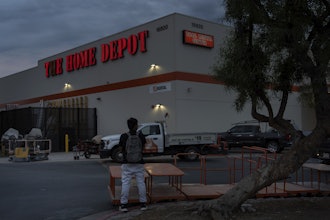Being stuck in the middle is often a bad thing. But what if you’re not stuck? What if, instead, you’re entrenched? An entrenched distributor, for example, would likely be in the driver’s seat, capable of straddling manufacturers and customers and calling the shots to their strategic benefit. The stuck distributor, on the other hand, probably has fewer options and is at risk of being marginalized or, even worse, being squeezed out of the supply chain altogether.
IBM’s Guy Blissett, author of the tenth edition of Facing the Forces of Change (a publication of the NAW Institute for Distribution Excellence), recently told an audience of distributors that they must innovate now or risk becoming obsolete. “For a variety of reasons, distributors are thinking about who they are, what they want to do, what value they bring to their customers, and how they want to differentiate themselves,” said Blissett. Apparently many of you agree: 85% of those surveyed for Forces of Change saw the need to innovate their business models.
If you feel stuck, even just a little bit, you’re probably behind the innovation curve. Good news, this article is for you. Because the secret to getting unstuck – or becoming more entrenched in your supply chain – is only a few clicks away. The secret is information.
Information is Currency
Whose job is it to look for customer buying patterns that show preference, fatigue and transition? It’s easy to say that it’s the manufacturer’s or supplier’s job, but it’s more forward-thinking to say that anyone in the supply chain can own this. Perhaps even you.
Information on what’s selling well, what’s not and what might be trending is as valuable as hard currency. You can use it to buy access to new partners or new markets, to elevate your standing with existing partners in your supply chain or you can simply apply it toward making your own business more efficient and profitable. Perhaps a simple example can bring this home.
Let’s say you notice that when a customer buys widget #1, they typically buy widget #2 a few months later. You explore this further and see that it’s not an anomaly – you see the same behavior in other customers. An idea soon emerges: what if the manufacturer packaged the two widgets, named the bundle and added a special price? Imagine the loyalty you’d earn – how much more deeply you’d become entrenched if you suggested this proactively.
This is just one example of adding value by simply having access to information.
Profiting from Information
Information flows freely throughout your company, but consolidating and deriving insights from that data isn’t as easy as it seems. But that’s changing. Today, thanks to barcodes, tablets and even smartphones, we can capture so much more in digital format than ever before. And with a little extra work, you can go almost completely paperless. When you reach that point, you’re able to do things within your supply chain that make partners happy, lower operational costs and increase margins.
Pressure to keep costs down and demonstrate value to partners is never-ending. Face it, if there’s any chance of disintermediating you – or, equally disconcerting, channeling less business your way, manufacturers and suppliers will do so. And, even if you’re able to fight for your survival, it’s likely you’ll lose anyway if you start offering incentives, promises or extras that your business’ numbers won’t support. Once you’re in a margin death spiral, the only way out is to make decisions with near perfect information.
How Information Adds Value
Information offers infinite possibilities. You can discover things about your business each day that drive greater efficiency or increased profits, but the impetus for becoming more data-driven can be as simple as providing better service. Large businesses have spent decades investing in customer relationship management (CRM), but it’s as much a change in business philosophy as it is technology. Let’s look at four areas where CRM thinking offers the greatest opportunity for distributors.
- Increased Automation – Taking steps to eliminate data entry not only streamlines order processing and reduces your labor costs, it also makes information more accurate, timely and, thanks to mobile devices, readily accessible. And supply chain partners love accuracy, timeliness and accessibility. Amazon.com is already legendary for the extent of its automation – it has transformed the way we think about books – and distribution – by reducing the number of human touches and dramatically improving visibility into what’s moving and what’s not. The lesson of Amazon is clear: automation doesn’t make sense of the data, but without it, data flows more slowly around your enterprise and can’t work as hard to provide insights that make customers happy, improve operations and increase margins.
- Improved Order Fulfillment – Timely, accurate access to order status is fundamental, but harder than it seems. Automation helps for sure, but integration is even more important. What if you’re able to quote order status, but the information you have is a week old? That’s not adding value. And what if this means you miss an opportunity to consolidate an order, which costs you more money and cuts into your margin. Without an integrated system of record that sees up and down the supply chain, as well as deeply into your own business, you’re as far from CRM as you can get.
- Smarter Delivery – Delivery isn’t simply about tracking the whereabouts of packages. That’s old thinking. Many distributors are surprised to learn how much inventory blindness affects on-time delivery and tests customer tolerance. How, for example, can you promise an order and set a delivery expectation without knowing what’s on-hand, what’s on order, what’s promised in the future, and so forth. Today, with technology available that provides real-time data on stock positions, including planned orders, quoting in a vacuum is unacceptable and a sure way to make your business expendable to an angry customer or, if it becomes a habit, angry partners who see you as weight on their brand reputation. As new models take root, such as manufacturers adopting pay-for-performance models, inefficiencies will no longer just affect customer satisfaction and loyalty, they’ll directly impact profitability.
- Demand-driven Collaboration - The wholesale distributors that remain on an island – data wise – risk continued isolation, and this simply doesn’t work in the new economy. Businesses that share data across a supply chain – forming new relationships with suppliers that include sharing of mutually beneficial data about customer trends and opportunities – will be clear winners. Some wholesale distributors are already pushing the envelope, allowing self-service access to data so that customer can actually place orders, check on statuses and do demand planning, all from the comfort of their own desk or tablet. Yes, this new type of relationship hinges on trust, but the early adopters say the benefits of transparency are well worth it.
Technology Isn’t the Hard Part
Automation and integration aren’t ends, they are means. Once you implement technology, the hard part is adapting your organization, including your extended supply chain, to capitalize the insights. And capitalize you must, because your customers have a very different expectation today than a decade ago. Our experiences as consumers – speed, self-service, loyalty discounts, expedited shipping, etc. – changes what we expect for our business relationships. And the dramatic evolution that’s taken place in the consumer realm was data-driven. So, it stands to reason, data is rapidly transforming this industry.
So it’s data, not technology, that’s transformational. And, thanks to decades of tinkering with complex technology platforms such as ERP and CRM, much of the kinks, as it were, have been smoothed out. And with the recent explosion of cloud technology, the barriers to technology adoption have never been lower. Even the smallest distributor can become a data-driven enterprise for less than the average family spends on groceries each month.
Fortunately, you and your employees don’t need to learn the cloud. That’s just an information superhighway and online bank (for data withdrawals) rolled into one. The technology that makes it easy to collect, store, and draw insights from data isn’t hard to learn either. And all of this is possible without expensive capital expenditure, space and expertise to operate.
What separates you from the benefits of increased automation, improved order fulfillment, smarter delivery and demand-driven collaboration – really just starting points, isn’t technology; it’s commitment. All you must do is commit to use readily accessible data as a way to become more deeply entrenched in your existing supply chain.
The Bottom Line
The distance between stuck and entrenched is massive. But the bridge between isn’t as long or perilous as some might think. But it must be built on information. During a period of such massive consolidation, channel convergence and evolving business models, you must be able to read and react to customers and partners with greater speed and precision. As hard as it might be to grasp, today’s leading distributors are looking out for their customer’s and partner’s revenue growth as much as their own. This is what “value-add” means today. If you can use data to drive new growth up and down your supply chain, your chances of being marginalized diminish considerably. And, finally, you’ll be entrenched, not stuck.
Steve Leavitt is the General Manager of U.S. Cloud Solutions for Exact where he is responsible for orchestrating the strategy and execution for the Exact Online business solutions for SMB manufacturers and wholesaler distributors. With more than 15 years of sales and cloud technology background, Steve has developed a keen understanding of the important contribution cloud solutions make for small businesses.






















